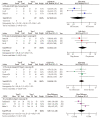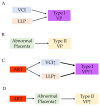The Characteristics and Obstetric Outcomes of Type II Vasa Previa: Systematic Review and Meta-Analysis
- PMID: 36552018
- PMCID: PMC9776262
- DOI: 10.3390/biomedicines10123263
The Characteristics and Obstetric Outcomes of Type II Vasa Previa: Systematic Review and Meta-Analysis
Abstract
Vasa previa is a rare fetal life-threatening obstetric disease classified into types I and II. This study aimed to examine the characteristics and obstetric outcomes of type II vasa previa. A systematic review was performed, and 20 studies (1998-2022) were identified. The results from six studies showed that type II vasa previa accounted for 21.3% of vasa previa cases. The characteristics and obstetric outcomes (rate of assisted reproductive technology (ART), antenatal diagnosis, emergent cesarean delivery, maternal transfusion, gestational age at delivery, and neonatal mortality) were compared between type I and II vasa previa, and all outcomes of interest were similar. The association between ART and abnormal placenta (bilobed placenta or succenturiate lobe) was examined in three studies, and the results were as follows: (i) increased rate of succenturiate lobes (ART versus non-ART pregnancy; OR (odds ratio) 6.97, 95% confidence interval (CI) 2.45-19.78); (ii) similar rate of abnormal placenta (cleavage-stage versus blastocyst embryo transfer); (iii) increased rate of abnormal placenta (frozen versus fresh embryo transfer; OR 2.97, 95%CI 1.10-7.96). Although the outcomes of type II vasa previa appear to be similar to those of type I vasa previa, the current evidence is insufficient for a robust conclusion.
Keywords: accessary lobes; assisted reproductive technique; bilobed placenta; succenturiate lobes; type II vasa previa; vasa previa.
Conflict of interest statement
The authors declare no conflict of interest.
Figures



References
-
- Mitchell S.J., Ngo G., Maurel K.A., Hasegawa J., Arakaki T., Melcer Y., Maymon R., Vendittelli F., Shamshirsaz A.A., Erfani H., et al. Timing of birth and adverse pregnancy outcomes in cases of prenatally diagnosed vasa previa: A systematic review and meta-analysis. Am. J. Obstet. Gynecol. 2022;227:173–181.e24. doi: 10.1016/j.ajog.2022.03.006. - DOI - PubMed
Publication types
LinkOut - more resources
Full Text Sources

